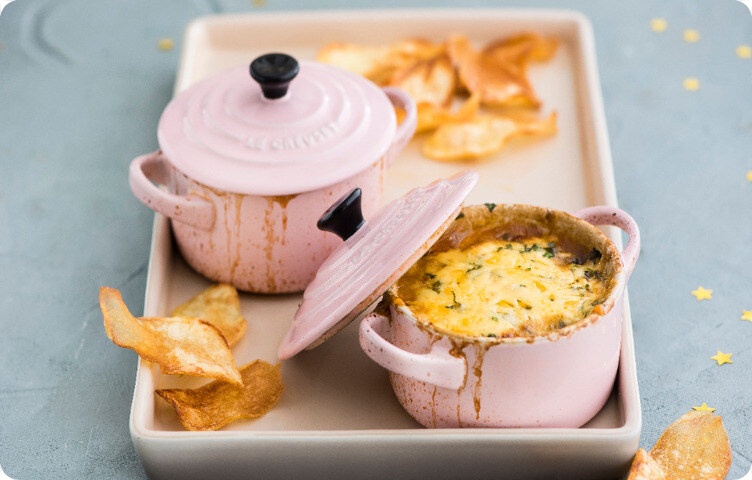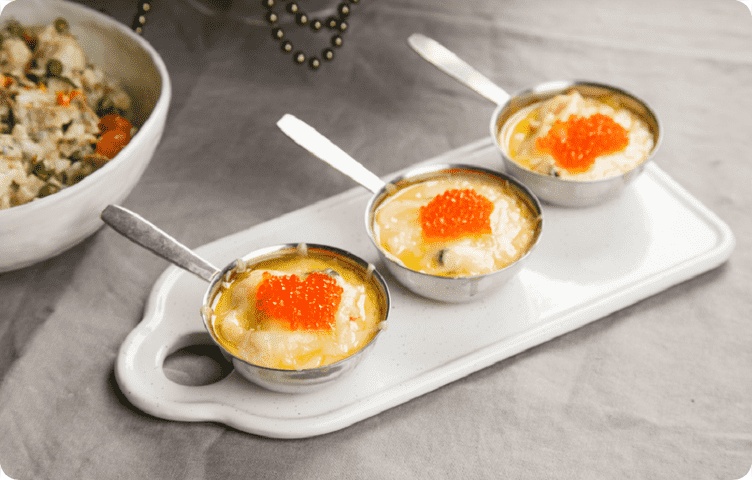Do you love julienne and dream of cooking it at home? This means you will have to get a cocotte pot - a small fireproof pot. You can’t make your favorite snack without it! But before you open online shopping sites, find out how to use unusual cookware.
What is the purpose of the cocotte maker?
The first who came up with the idea of baking vegetables with cheese were the kings of cooking - the French. Already 300 years ago, French chefs prepared julienne in small ceramic saucepans. Such dishes were called “cocotte”, which means “chicken”. Chicken meat, along with vegetables, cheese, and mushrooms, was a popular ingredient in julienne.
The shape of the product resembles a deep ladle. The extended handle makes it easier to move the utensils. The product is often supplemented with a lid. The small volume of the cookware allows thinly sliced foods to be baked evenly. Soaked in their own juices, the ingredients turn into a smooth, tender snack. The dish is convenient to serve, since the saucepan is designed for one serving.
Types of cocotte makers
French pots must withstand temperatures from +180ᵒ C. Therefore, they are made of refractory ceramics, steel, and cast iron. Types of cookware are classified according to materials.
Ceramic and porcelain cocotte makers
Initially, all julienne saucepans were made of clay. Natural material retains heat well inside and prevents food from burning. Ceramics do not give off foreign tastes and preserve the natural aromas of products. Ceramic products look beautiful on the table.
The main disadvantage of the material is fragility. Ceramic pots cannot withstand temperature changes; they need to be heated gradually. Stores offer glazed and unglazed cocotte makers. The first option is easier to clean and more resistant to temperature changes. Unglazed products absorb fat, so they are difficult to wash.

Stainless steel
Durable material ensures durability, heat resistance, and practicality of the cookware. Steel cocotte makers are thin-walled, lightweight, and easy to move inside the stove. The smooth surface is easy to clean with ordinary household chemicals. But metal objects should not be placed in the microwave. If the bottom is not thick enough, it may become deformed.

Cast iron cocotte maker
The thick metal heats up quickly, distributing the heat evenly inside. Thanks to this, the food turns out especially juicy. A good cast iron cocotte maker can be used as a saucepan, mini-saucepan, or frying pan. Natural carbon deposits that gradually form on the surface act as a non-stick coating.
But cast iron is not universal - it does not tolerate temperature changes well and takes a long time to cool down. Cast iron pots weigh a lot, which is inconvenient when serving. You need to take special care of them - do not soak them in water, wipe them dry after washing.

How to choose?
If the dishes are intended only for juliennes, you can buy small ceramic molds. They are suitable for the oven, microwave, and will decorate the table setting.
But those who are going to cook a variety of dishes need to consider 5 points:
- heat resistance - the dishes must withstand +180-200ᵒ C;
- the presence of a non-stick coating - only metal cocotte makers are equipped with a protective layer. Titanium coating is considered the most durable and safe;
- equipment - convenient when the dishes are complemented with a lid and removable handles;
- care – you should avoid products that can only be washed with certain products.
- volume - it is better to purchase small pots with a capacity of 50-150 ml than one large product.
If you are going to serve cocotte makers to guests, choose elegant products - painted, glazed.
Rules of care
Features of washing, cleaning, and storage depend on the material of the product. The easiest way to care for stainless steel is that it tolerates water, hard sponges, and any household chemicals well. Steel cookware can be washed by hand or in the dishwasher.
Cast iron products are more capricious. Do not pour cool water over a hot pot - it may crack. Prolonged soaking causes rust, so immediately after washing the dishes should be dried with a dry towel.
Ceramic and porcelain cocotte makers can be washed not only by hand, but also in the dishwasher. If the product is unglazed, aggressive grease removers should not be used. Good ceramics should not be dried in direct sunlight - it may lose color. Store products on a separate shelf to protect them from damagelearning other subjects.
What is a cocotte maker for?
The traditional purpose of small pots is to prepare julienne. This hot appetizer looks more impressive when served in portions. The long handle helps to handle the utensils while the food is being prepared, and then to hold it while eating.
Now cocotte makers are used to prepare dozens of dishes, including:
- vegetable stew;
- soups;
- casseroles;
- souffle;
- muffins;
- puddings.
The most famous snack, which is baked in portions, has a characteristic name - cocotte eggs.
What can you cook in a cocotte maker?
The use of small pots is very extensive - baking, stewing, frying, creating sweet pastries. It is most convenient to prepare hot breakfasts. Eggs, fish casseroles, vegetable julienne are excellent morning dishes.
There are hundreds of recipes for hot appetizers that use fireproof saucepans. Among them:
- gratins;
- pates from liver, fish, mushrooms;
- snack cupcakes;
- cheese soufflé;
- chicken or fish pies.
The Portion Pot is essential for making the famous French onion soup. Simmering enhances the spicy taste of Thai shrimp soups and Russian fish soup. The baking method is convenient for preparing chicken roast, baked seafood, and beef stew.
Portion cutlery plays a special role in children's kitchens. The potato casserole that kids love looks especially attractive in a bright little saucepan.
Small confectionery products look even more tempting. Cheese pancakes, mini cheesecakes, creme brulee - the list of recipes is limited only by the cook’s imagination.
Popular manufacturers
Many tableware factories produce cocotte makers, but the highest customer ratings belong to five companies:
Borisov Ceramics - produces more than 50 types of products. Among them are glazed ceramic pots with a volume of 100-250 ml. The products are characterized by heat resistance and exquisite design. A number of models are made by hand.
Nytva is a domestic brand that produces portioned pots with a volume of 50-150 ml. Product material – stainless steel. The product is oven-safe, does not require special care, and retains its beautiful appearance after repeated use.
Prohotel is the Complex-Bar brand. Offers stainless steel cocotte makers with a volume of 70-170 ml. The models have classic shapes - a low “bucket”, a cylinder, a round pot. The products are heat-resistant and can be washed with any household chemicals. Remains shiny after prolonged use.
Revol is a French culinary brand that creates elegant kitchen utensils. Produces more than 100 models of porcelain cocotte makers. The dishes are made in the form of miniature pans, pots, hearts, pumpkins. Revol products are suitable for oven, microwave and stovetop.
Kunstwerk is a Kompleks-Bar brand that produces high-quality tableware. It produces pots made of refractory porcelain with a volume of 70-160 ml, and sets of julienne bowls of 2-6 items. The products are manufactured using modern technologies, therefore they are characterized by increased durability.
















































/https%3A%2F%2Fcomplexbar.com%2Fimages%2Fblog%2F130%2Fkokotnitsy-osobennosti.jpg)
/https%3A%2F%2Fcomplexbar.com%2Fimages%2Fblog%2F245%2Fskov_glavn.jpeg)
/https%3A%2F%2Fcomplexbar.com%2Fimages%2Fblog%2F245%2Fhaiboli.jpg)
/https%3A%2F%2Fcomplexbar.com%2Fimages%2Fblog%2F245%2Fvilki-na-stole-752x480.jpeg)
/https%3A%2F%2Fcomplexbar.com%2Fimages%2Fblog%2F246%2F2024-04-09_17.22.54.jpg)
/https%3A%2F%2Fcomplexbar.com%2Fimages%2Fblog%2F246%2F2024-04-09_17.22.47.jpg)
/https%3A%2F%2Fcomplexbar.com%2Fimages%2Fblog%2F246%2FCODE_anons_foamydrops_752%D1%85480_eng.jpg)
/https%3A%2F%2Fcomplexbar.com%2Fimages%2Fblog%2F246%2FAlina_752%D1%85480_eng.jpg)
/https%3A%2F%2Fcomplexbar.com%2Fimages%2Fblog%2F246%2F2024-04-09_17.23.22.jpg)
/https%3A%2F%2Fcomplexbar.com%2Fimages%2Fblog%2F246%2F2024-04-09_17.23.28.jpg)
/https%3A%2F%2Fcomplexbar.com%2Fimages%2Fblog%2F246%2F2024-04-09_17.23.35.jpg)
/https%3A%2F%2Fcomplexbar.com%2Fimages%2Fblog%2F246%2Fdrinksome_752%D1%85480_eng.jpg)
/https%3A%2F%2Fcomplexbar.com%2Fimages%2Fblog%2F246%2Fnude_752%D1%85480_eng.jpg)
/https%3A%2F%2Fcomplexbar.com%2Fimages%2Fblog%2F246%2F752%D1%85480_eng__1_.jpg)
/https%3A%2F%2Fcomplexbar.com%2Fimages%2Fblog%2F246%2F752%D1%85480_eng.jpg)
/https%3A%2F%2Fcomplexbar.com%2Fimages%2Fblog%2F246%2FStudioRaw_752%D1%85480_eng.jpg)
/https%3A%2F%2Fcomplexbar.com%2Fimages%2Fblog%2F246%2FDoppio_tea_752%D1%85480_eng.jpg)
/https%3A%2F%2Fcomplexbar.com%2Fimages%2Fblog%2F246%2FTognana_Stars_Stripes_752%D1%85480_eng.jpg)
/https%3A%2F%2Fcomplexbar.com%2Fimages%2Fblog%2F246%2FRona_752%D1%85480_eng.jpg)
/https%3A%2F%2Fcomplexbar.com%2Fimages%2Fblog%2F246%2FDoppio_vending_752%D1%85480_eng.jpg)
/https%3A%2F%2Fcomplexbar.com%2Fimages%2Fblog%2F246%2FEssence_sukhie_smesi_752%D1%85480_eng.jpg)
/https%3A%2F%2Fcomplexbar.com%2Fimages%2Fblog%2F246%2FODK_sukhie_smesi752%D1%85480_eng.jpg)
/https%3A%2F%2Fcomplexbar.com%2Fimages%2Fblog%2F246%2Funiforma-barmena.jpg)
/https%3A%2F%2Fcomplexbar.com%2Fimages%2Fblog%2F246%2Fkak-nanyat-barmena.jpg)
/https%3A%2F%2Fcomplexbar.com%2Fimages%2Fblog%2F246%2Fsirop_scale_2400.jpeg)
/https%3A%2F%2Fcomplexbar.com%2Fimages%2Fblog%2F246%2FPeugeot_Anons_Paris_U%27Select_Line_Daman_752%D1%85480_eng.jpg)
/https%3A%2F%2Fcomplexbar.com%2Fimages%2Fblog%2F246%2Fkofe-vostochniy.jpg)
/https%3A%2F%2Fcomplexbar.com%2Fimages%2Fblog%2F246%2FMadler.jpg)
/https%3A%2F%2Fcomplexbar.com%2Fimages%2Fblog%2F246%2Fprofbartender_glavn.jpeg)